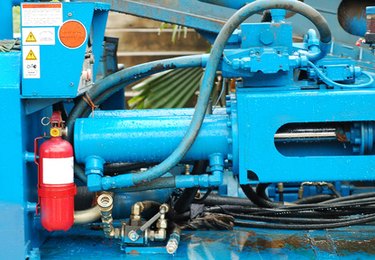
A hydraulic cylinder refers to an actuator device, or device used to move or control a mechanism, that converts hydraulic energy into linear mechanical energy. Performing a drift test for a malfunctioning hydraulic cylinder can pinpoint the cause of an operational problem.
Drift Definition
Video of the Day
Drift refers to a hydraulic cylinder piston -- which typically moves up and down to produce hydraulic power -- sinking down into the cylinder and seizing, or stopping all motion. Drift typically occurs due to a piston seal leak, resulting in excess oil in the cylinder.
Video of the Day
Drift Test
The drift test for a hydraulic cylinder refers to testing the integrity of the piston seal by pressurizing the cylinder at the end of stroke to determine the amount of leakage past the seal. This test, often referred to as the "end-of-stroke bypass test," involves manually manipulating the piston.
Drift Test Procedure
The drift test for a hydraulic cylinder essential involves placing the cylinder on a stand, filling the cylinder with oil in the extend and retract ports, and extending and retracting the cylinder using the directional control valve. The cylinder end port must be pressurized to standard operating pressure via the relief valve. Leaks around the rod seal can then be detected.